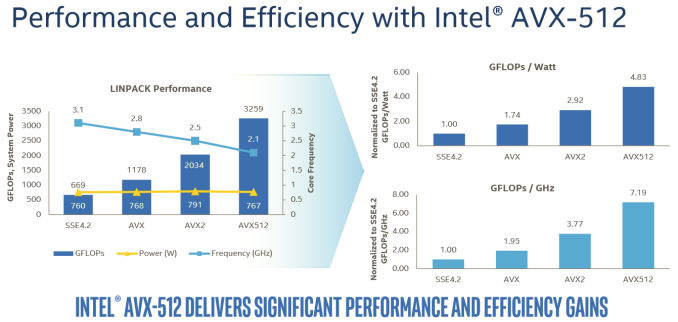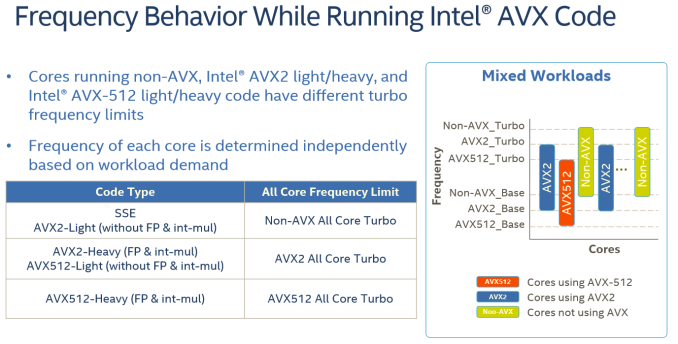Sizing Up Servers: Intel's Skylake-SP Xeon versus AMD's EPYC 7000 - The Server CPU Battle of the Decade?
by Johan De Gelas & Ian Cutress on July 11, 2017 12:15 PM EST- Posted in
- CPUs
- AMD
- Intel
- Xeon
- Enterprise
- Skylake
- Zen
- Naples
- Skylake-SP
- EPYC
Introducing Skylake-SP: The Xeon Scalable Processor Family
The biggest news hitting the streets today comes from the Intel camp, where the company is launching their Skylake-SP based Xeon Scalable Processor family. As you have read in Ian's Skylake-X review, the new Skylake-SP core has been rather significantly altered and improved compared to it's little brother, the original Skylake-S. Three improvements are the most striking: Intel added 768 KB of per-core L2-cache, changed the way the L3-cache works while significantly shrinking its size, and added a second full-blown 512 bit AVX-512 unit.
On the defensive and not afraid to speak their mind about the competition, Intel likes to emphasize that AMD's Zen core has only two 128-bit FMACs, while Intel's Skylake-SP has two 256-bit FMACs and one 512-bit FMAC. The latter is only useable with AVX-512. On paper at least, it would look like AMD is at a massive disadvantage, as each 256-bit AVX 2.0 instruction can process twice as much data compared to AMD's 128-bit units. Once you use AVX-512 bit, Intel can potentially offer 32 Double Precision floating operations, or 4 times AMD's peak.
The reality, on the other hand, is that the complexity and novelty of the new AVX-512 ISA means that it will take a long time before most software will adopt it. The best results will be achieved on expensive HPC software. In that case, the vendor (like Ansys) will ask Intel engineers to do the heavy lifting: the software will get good AVX-512 support by the expensive process of manual optimization. Meanwhile, any software that heavily relies on Intel's well-optimized math kernel libraries should also see significant gains, as can be seen in the Linpack benchmark.
In this case, Intel is reporting 60% better performance with AVX-512 versus 256-bit AVX2.
For the rest of us mere mortals, it will take a while before compilers will be capable of producing AVX-512 code that is actually faster than the current AVX binaries. And when they do, the result will be probably be limited, as compilers still have trouble vectorizing code from scratch. Meanwhile it is important to note that even in the best-case scenario, some of the performance advantage will be negated by the significantly lower clock speeds (base and turbo) that Intel's AVX-512 units run at due to the sheer power demands of pushing so many FLOPS.
For example, the Xeon 8176 in this test can boost to 2.8 GHz when all cores are active. With AVX 2.0 this is reduced to 2.4 GHz (-14%), with AVX-512, the clock tumbles down to 1.9 GHz (another 20% lower). Assuming you can fill the full width of the AVX unit, each step still sees a significant performance improvement, but AVX2 to AVX-512 won't offer a full 2x performance improvement even with ideal code.
Lastly, about half of the major floating point intensive applications can be accelerated by GPUs. And many FP applications are (somewhat) limited by memory bandwidth. While those will still benefit from better AVX code, they will show diminishing returns as you move from 256-bit AVX to 512-bit AVX. So most FP applications will not achieve the kinds of gains we saw in the well-optimized Linpack binaries.













219 Comments
View All Comments
Shankar1962 - Thursday, July 13, 2017 - link
So you think Intel won't release anything new again by then? Intel would be ready for cascadelake by then. None of the big players won't switch to AMD. Skylake alone is enough to beat epyc handsomely and cascadelake will just blow epyc. Its funny people are looking at lab results when real workloads are showing 1.5-1.7x speed improvementPixyMisa - Saturday, July 15, 2017 - link
This IS comparing AMD to Intel's newest CPUs, you idiot. Skylake loses to Epyc outright on many workloads, and is destroyed by Epyc on TCO.Shankar1962 - Sunday, July 16, 2017 - link
Mind your language assholeEither continue the debate or find another place for your shit and ur language
Real workloads don't happen in the labs you moron
Real workloads are specific to each company and Intel is ahead either way
If you have the guts come out with Q3 Q4 2017 and 2018 revenues from AMD
If you come back debating epyc won over skylake if AMD gets 5-10% share then i pity your common sense and your analysis
You are a bigger idiot because you spoiled a healthy thread where people were taking sides by presenting technical perspective
PixyMisa - Tuesday, July 25, 2017 - link
I'm sorry you're an idiot.Shankar1962 - Thursday, July 13, 2017 - link
Does not matter. We can debate this forever but Intel is just ahead and better optimized for real world workloads. Nvidia i agree is a potential threat and ahead in AI workloads which is the future but AMD is just an unnecessary hype. Since the fan boys are so excited with lab results (funny) lets look at Q3,Q4 results to see how many are ordering to test it for future deployment.martinpw - Wednesday, July 12, 2017 - link
I'm curious about the clock speed reduction with AVX-512. If code makes use of these instructions and gets a speedup, will all other code slow down due to lower overall clock speeds? In other words, how much AVX-512 do you have to use before things start clocking down? It feels like it might be a risk that AVX-512 may actually be counterproductive if not used heavily.msroadkill612 - Wednesday, July 12, 2017 - link
(sorry if a repost)Well yeah, but this is where it starts getting weird - 4-6 vega gpuS, hbm2 ram & huge raid nvme , all on the second socket of your 32 core, c/gpu compute ~Epyc server:
https://marketrealist.imgix.net/uploads/2017/07/A1...
from
http://marketrealist.com/2017/07/how-amd-plans-to-...
All these fabric linked processors, can interact independently of the system bus. Most data seems to get point to point in 2 hops, at about 40GBps bi-directional (~40 pcie3 lanes, which would need many hops), and can be combined to 160GBps - as i recall.
Suitably custom hot rodded for fabric rather than pcie3, the nvme quad arrays could reach 16MBps sequential imo on epycs/vegaS native nvme ports.
To the extent that gpuS are increasing their role in big servers, intel and nvidea simply have no answer to amd in the bulk of this market segment.
davide445 - Wednesday, July 12, 2017 - link
Finally real competition in the HPC market. Waiting for the next top500 AMD powered supercomputer.Shankar1962 - Wednesday, July 12, 2017 - link
Intel makes $60billion a year and its official that Skylake was shipping from Feb17 so i do not understand this excitement from AMD fan boys......if it is so good can we discuss the quarterly revenues between these companies? Why is AMD selling for very low prices when you claim superior performance over Intel? You can charge less but almost 40-50% cheap compared to Intel really?AMD exists because they are always inferior and can beat Intel only by selling for low prices and that too for what gaining 5-10% market which is just a matter of time before Intel releases more SKUs to grab it back
What about the software optimizations and extra BOM if someone switches to AMD?
What if AMD goes into hibernation like they did in last 5-6years?
Can you mention one innovation from AMD that changed the world?
Intel is a leader and all the technology we enjoy today happenned because of Intel technology.
Intel is a data center giant have head start have the resources money acquisitions like altera mobileeye movidus infineon nirvana etc and its just impossible that they will lose
Even if all the competent combines Intel will maintain atleast 80% share even 10years from now
Shankar1962 - Wednesday, July 12, 2017 - link
To add onNo one cares about these lab tests. Let's talk about the real world work loads.
Look at what Google AWS ATT etc has to say as they already switched to xeon sky lake
We should not really be debating if we have the clarity that we are talking about AMD getting just 5% -10% share by selling high end products they have for cheap prices....they fo not make too much money by doing that.....they have no other option as thats the only way they can dream of a 5-10% market share
For Analogy think Intel in semiconductor as Apple in selling smartphones
Intel has gross margins of ~63%
They have a solid product portfolio technologies and roadmap .....we can debate this forever but the revenues profits innovations and history between these companies can answer everything